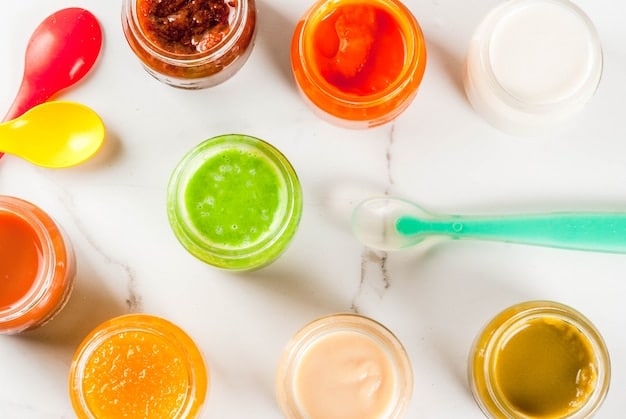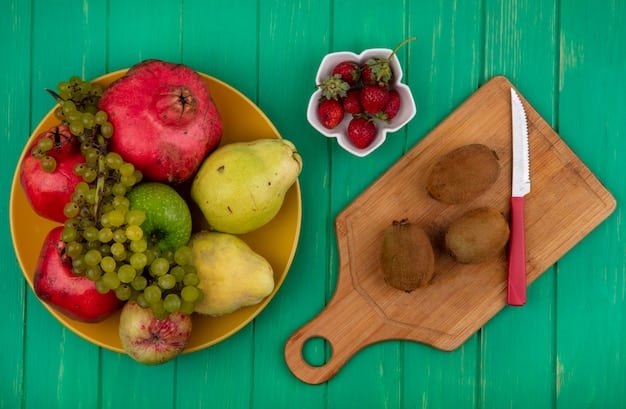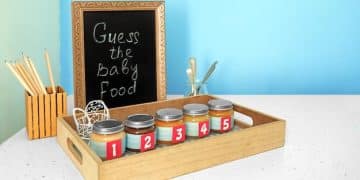Baby Food Blitz: Make a Month’s Worth of Puree in 2 Hours!

Baby Food Blitz: Make a Month’s Worth of Nutritious Purees in 2 Hours is a time-saving strategy for busy parents, enabling them to prepare a month’s supply of healthy, homemade baby food in a single, efficient cooking session.
Are you a busy parent struggling to find time to prepare fresh, nutritious meals for your little one? The Baby Food Blitz: Make a Month’s Worth of Nutritious Purees in 2 Hours is the answer! This revolutionary method allows you to create a month’s worth of delicious, homemade baby food in just one afternoon.
The Ultimate Baby Food Blitz Guide
Making your own baby food might seem daunting. But it can be surprisingly easy and incredibly rewarding. By following a structured approach you get to control exactly what your baby eats – ensuring they get the freshest and most nutritious meals possible.
This guide is your roadmap to mastering the baby food blitz. We’ll will provide you with step-by-step instructions, helpful tips, and delicious recipes that will empower you to confidently create a month’s supply of baby food in just a couple of hours. Say goodbye to store-bought jars and hello to homemade goodness!
Why Choose a Baby Food Blitz?
Making your own baby food offers numerous benefits, from cost savings to nutritional control. A baby food blitz takes these advantages and supercharges them by consolidating your effort into a single, efficient session.
It’s a method perfectly tailored for the fast-paced lives of modern parents!
Savings Galore: The Financial Benefits
One of the most immediate benefits is the cost savings. Store-bought baby food can be expensive, especially if you prioritize organic options.
By making your own, you’re paying only for the raw ingredients, which are often significantly cheaper.
Complete Control: Nutritional Supremacy
When you make your own baby food, you have complete control over the ingredients. You can choose organic fruits and vegetables, avoid added sugars and preservatives, and tailor the recipes to your baby’s specific dietary needs and preferences.
- No Hidden Nasties: Avoid artificial additives, preservatives, and excessive sodium.
- Allergen Awareness: Easily control ingredients to avoid potential allergens.
- Customized Nutrition: Tailor recipes to meet your baby’s specific nutritional needs.
This peace of mind is invaluable, especially for parents concerned about the quality and safety of their baby’s food.
With homemade baby food, you side-step the common, and sometimes hidden, culprits of commercial baby food.
You’ll also know exactly what fresh ingredients are in the puree.
In summary, the Baby Food Blitz is worth the effort.

Planning Your Baby Food Blitz
The key to a successful baby food blitz is meticulous planning. Start by selecting simple recipes.
Consider what’s in season. Ensure you’re utilizing ingredients that are readily available at your local grocery store or farmers market.
Recipe Selection and Quantity Calculation
Choose 2-3 recipes to start with. This will give your baby variety while keeping the process manageable.
Consider classic combinations like sweet potato and apple, carrot and zucchini, or pea and pear.
Once you’ve selected your recipes, calculate the amount of each ingredient you’ll need to make a month’s worth of food. A good rule of thumb is to prepare around 2-4 ounces of puree per meal, depending on your baby’s age and appetite.
The Ultimate Grocery List
Create a detailed grocery list. Organize your list by category to make shopping easier. Don’t forget to include any spices or herbs you might want to add for flavor!
With a well-organized grocery list, your ingredient shopping experience will be more convenient.
Planning allows you to be more efficient by buying in bulk.
Essential Equipment Checklist:
- Steamer Basket: For gentle cooking that retains nutrients.
- Food Processor or Blender: To achieve the perfect puree consistency.
- Ice Cube Trays or Small Containers: For portioning and freezing.
- Freezer Bags: For long-term storage.
Having the right tools will make the process smoother and more enjoyable.
Proper preparation is critical. Planning will allow you to make your blitz as efficient as possible. This upfront labor will allow you to make the most of your 2 hour time crunch.
Step-by-Step Guide to the Blitz
With your plan in place, it’s time to start the blitz!
Set up a clean and organized workspace, gather all your ingredients and equipment, and get ready to puree.
Prep the Ingredients: Wash, Peel, Chop
Thoroughly wash all fruits and vegetables. Remove any peels, seeds, or cores as needed. Chop the ingredients into small, uniform pieces to ensure even cooking.
This step is crucial for achieving a smooth and consistent puree.
Cut corners here and you may end of having uneven puree batches.
Uniform preparation can increase your efficiency during the baby food blitz.
Cook the Ingredients: Steaming or Roasting
Steaming is an excellent method for cooking baby food because it preserves nutrients and flavor.
Place the chopped ingredients in a steamer basket over boiling water and cook until tender, usually around 10-15 minutes.
Alternatively, you can roast certain ingredients like sweet potatoes or butternut squash for a richer flavor. Roasting also caramelizes the natural sugars.
- Steaming: Great for preserving nutrients and creating a mild flavor.
- Roasting: Adds a deeper, sweeter flavor profile to certain vegetables.
- Boiling: A quick way to soften ingredients but can leach out some nutrients.
Puree to Perfection: Achieving the Right Consistency
Once the ingredients are cooked, transfer them to a food processor or blender. Add a small amount of water, breast milk, or formula to help achieve a smooth and creamy consistency.
Blend until the puree is completely smooth, with no lumps or chunks.
For younger babies, strive for a thinner consistency. For older babies, it may be suitable to leave some texture.
Executing a blitz can be stressful. However, this step-by-step process can help make it more manageable.
Creative Puree Combinations
Experimenting with different flavor combinations can introduce your baby to a wide range of tastes and textures.
Don’t be afraid to get creative and try new things.
Fruity Delights: Sweet and Nutritious
Fruit purees are a great way to introduce natural sweetness into your baby’s diet.
Try combinations like apple and cinnamon, banana and blueberry, or mango and avocado.
These blends are packed with vitamins, minerals, and antioxidants that are essential for your baby’s growth and development.
Vegetable Ventures: Savory Sensations
Vegetable purees can sometimes be a harder sell for babies, but with the right combinations, they can be just as appealing.
Try mixing sweet vegetables like carrots or sweet potatoes with mild-flavored greens like spinach or zucchini.
You can also add a touch of herbs like parsley or thyme for extra flavor.

Adding Spices and Herbs: Flavor Enhancement
Spices and herbs can add a depth of flavor to your baby’s food, making it more interesting and palatable.
Start with small amounts and gradually increase as your baby gets used to the new tastes.
- Cinnamon: Adds warmth and sweetness to fruit purees.
- Nutmeg: Complements root vegetables like sweet potatoes and squash.
- Parsley: Provides a fresh, herbaceous note to savory blends.
Introducing your baby to a variety of flavors early on can expand their palate and encourage adventurous eating habits later in life.
Your puree combinations have endless possibilities. From sweet to savory you can tailor the flavor to the baby’s preferences.
Safe Storage and Thawing
Proper storage and thawing are crucial for maintaining the quality and safety of your homemade baby food.
Follow these guidelines to ensure your baby is getting the safest and most nutritious meals possible.
Portioning: Ice Cube Trays or Small Containers
Once the puree is cooled, transfer it to ice cube trays or small, freezer-safe containers.
This allows you to portion out individual servings, making mealtime quick and easy.
Be sure to leave a little bit of space at the top of each container, as the puree will expand slightly when frozen.
Freezing: Maximizing Freshness
Place the filled ice cube trays or containers in the freezer. Once the puree is frozen solid, pop the cubes out of the trays and transfer them to freezer bags. Label each bag with the date and contents to keep track of what you have on hand.
Homemade baby food can be stored in the freezer for up to 3 months.
This ensures you always have a supply of fresh, nutritious meals ready for your little one.
Thawing: Safe and Convenient Methods
There are several safe and convenient ways to thaw baby food. You can transfer a portion from the freezer to the refrigerator overnight, or you can use the microwave on a low setting.
Be sure to stir the puree well and check the temperature before serving to your baby.
- Refrigerator: A slow and gentle thawing method that preserves the flavor and texture of the puree.
- Microwave: A quick option for thawing, but be sure to stir well and check for hot spots.
- Warm Water Bath: Place the container of frozen puree in a bowl of warm water to thaw quickly.
Always discard any leftover thawed baby food to prevent bacterial contamination.
By following these storage and thawing guidelines, you can ensure that your baby is getting the safest and most nutritious meals.
Proper storage can maximize your nutritional efforts. Without doing so, you risk bacterial contamination.
Troubleshooting and Tips for Success
While the baby food blitz is a relatively straightforward process, there are a few common issues that parents may encounter.
Here are some troubleshooting tips and expert advice to help you succeed.
Lumpy Puree: Achieving a Smooth Texture
If your puree is lumpy, it could be due to not cooking the ingredients long enough or not blending them thoroughly.
Try cooking the ingredients a little longer until they are very tender, and then blend for a longer period of time.
You can also add a bit more liquid to help achieve a smoother consistency.
Baby Refuses to Eat: Introducing New Flavors
If your baby is refusing to eat a particular puree, it could be due to the taste or texture. Try mixing a small amount of the new puree with a familiar one to help ease the transition.
You can also try different combinations of flavors to find what your baby enjoys.
Allergic Reactions: Identifying and Avoiding
When introducing new foods to your baby, it’s important to watch for any signs of allergic reactions. Start with one new food at a time and wait a few days before introducing another.
If you notice any symptoms like rash, hives, swelling, or difficulty breathing, stop feeding the food immediately and consult your pediatrician.
Expert Tips for a Smooth Blitz:
- Batch Cooking: Double or triple your recipes to maximize efficiency.
- Label Everything: Clearly label all containers and bags with the date and contents.
- Involve Your Partner: Make it a team effort to speed up the process.
With a little bit of practice and these helpful tips, you’ll be able to master the baby food blitz and provide your baby with nutritious, homemade meals in no time.
Overcome common snags and achieve your nutritional requirements.
| Key Point | Brief Description |
|---|---|
| 💰 Cost Savings | Homemade baby food is cheaper than store-bought alternatives. |
| 🍎 Nutritional Control | You control the ingredients, avoiding additives and preservatives. |
| ⏱️ Time Efficiency | Prepare a month’s worth of food in just 2 hours. |
| 👶 Flavor Variety | Experiment with combinations to introduce your baby to a range of tastes. |
Frequently Asked Questions
▼
You’ll need a steamer basket, food processor or blender, ice cube trays or small containers, and freezer bags. These tools will help you prepare and store the purees efficiently.
▼
Frozen baby food can be stored for up to 3 months. Always label the containers with the date so that you can track the duration of storage to preserve the baby food.
▼
Thaw baby food in the refrigerator overnight or carefully use a microwave on low setting, ensuring to stir and test for hot spots before serving to the baby.
▼
If your baby refuses a puree, try mixing only in a small amount gradually to a familiar puree flavor, or try introducing it at varying times.
▼
Yes, you can add spices in moderation to introduce new tastes and enrich baby foods. Do so in tiny amounts to start off incrementally, in small doses.
Conclusion
The Baby Food Blitz: Make a Month’s Worth of Nutritious Purees in 2 Hours is a game-changer for busy parents who want to provide their babies with the best possible nutrition. With careful planning, efficient execution, and creative combinations, you can create a freezer full of delicious and healthy meals that will nourish your baby and simplify your life.





